wheel Lexus GX470 2007 Theft deterrent system / LEXUS 2007 GX470 (OM60C64U) Workshop Manual
[x] Cancel search | Manufacturer: LEXUS, Model Year: 2007, Model line: GX470, Model: Lexus GX470 2007Pages: 436, PDF Size: 11.52 MB
Page 359 of 436
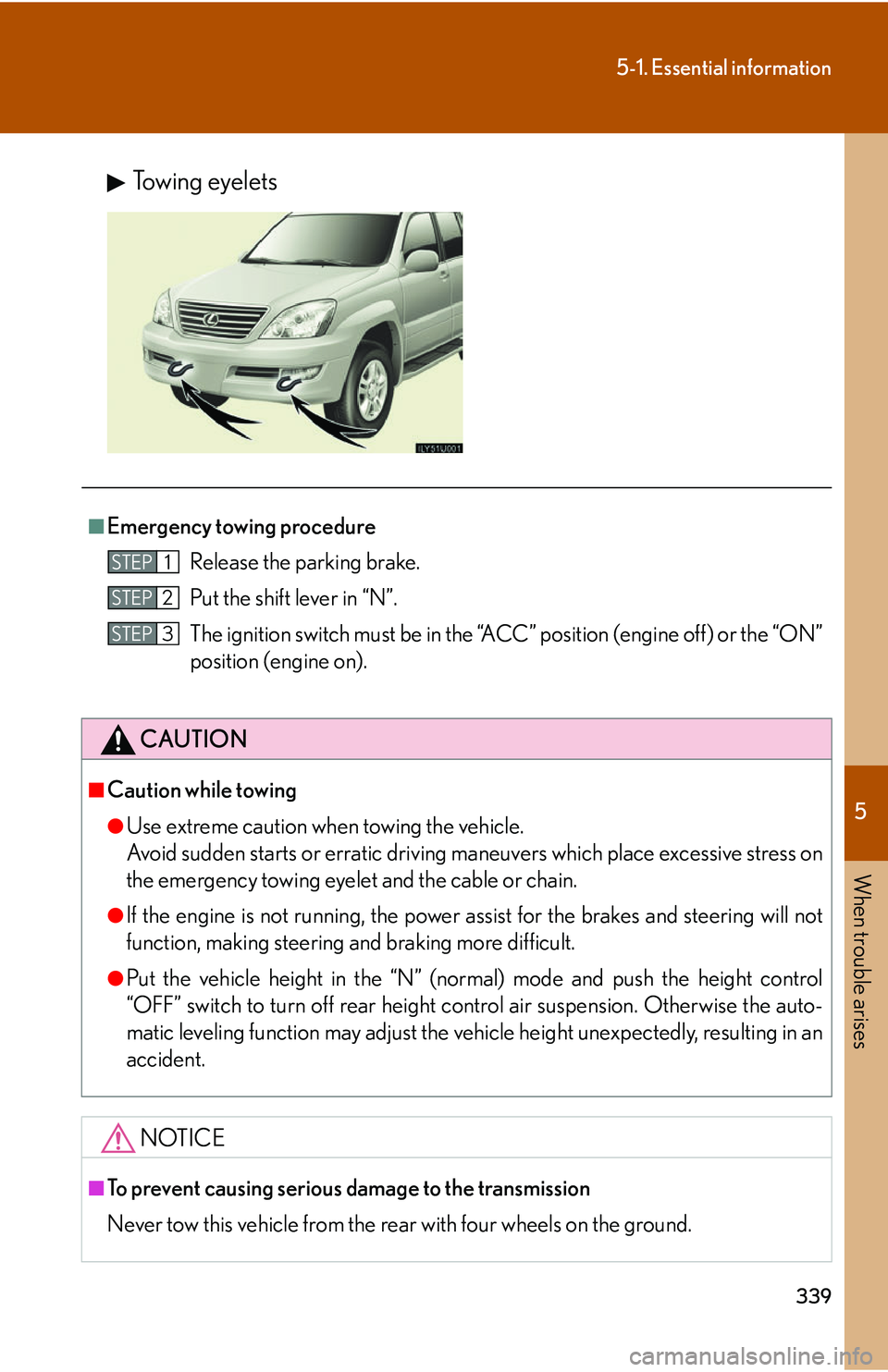
5
When trouble arises
339
5-1. Essential information
Towing eyelets
■Emergency towing procedureRelease the parking brake.
Put the shift lever in “N”.
The ignition switch must be in the “ACC” position (engine off) or the “ON”
position (engine on).
CAUTION
■Caution while towing
●Use extreme caution when towing the vehicle.
Avoid sudden starts or erratic driving maneuvers which place excessive stress on
the emergency towing eyelet and the cable or chain.
●If the engine is not running, the power assi st for the brakes and steering will not
function, making steering and braking more difficult.
●Put the vehicle height in the “N” (normal) mode and push the height control
“OFF” switch to turn off rear height co ntrol air suspension. Otherwise the auto-
matic leveling function may adjust the vehicle height unexpectedly, resulting in an
accident.
NOTICE
■To prevent causing serious damage to the transmission
Never tow this vehicle from the rear with four wheels on the ground.
STEP1
STEP2
STEP3
Page 360 of 436
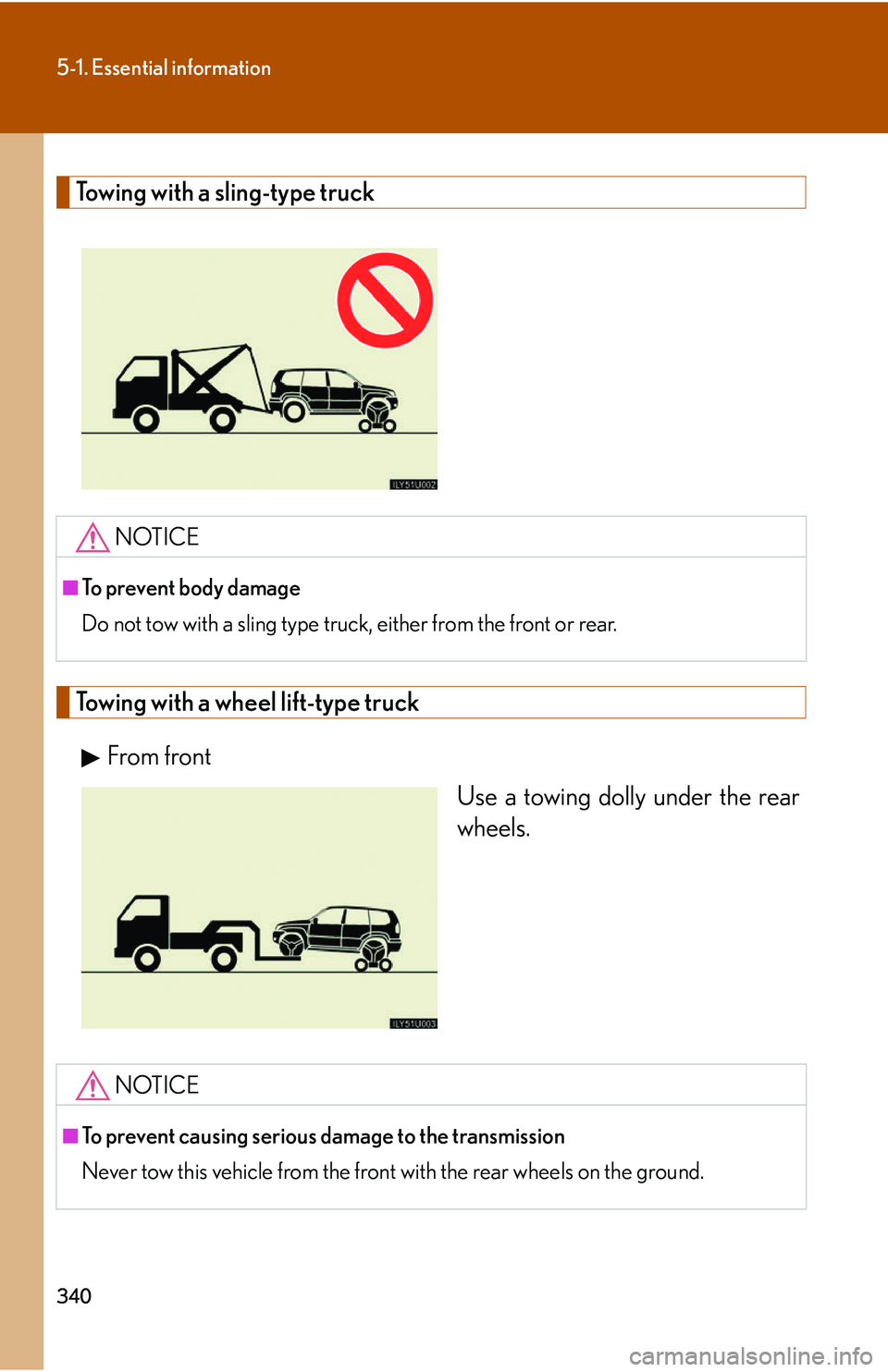
340
5-1. Essential information
Towing with a sling-type truck
Towing with a wheel lift-type truckFrom front Use a towing dolly under the rear
wheels.
NOTICE
■To prevent body damage
Do not tow with a sling type truck, either from the front or rear.
NOTICE
■To prevent causing serious damage to the transmission
Never tow this vehicle from the front with the rear wheels on the ground.
Page 361 of 436
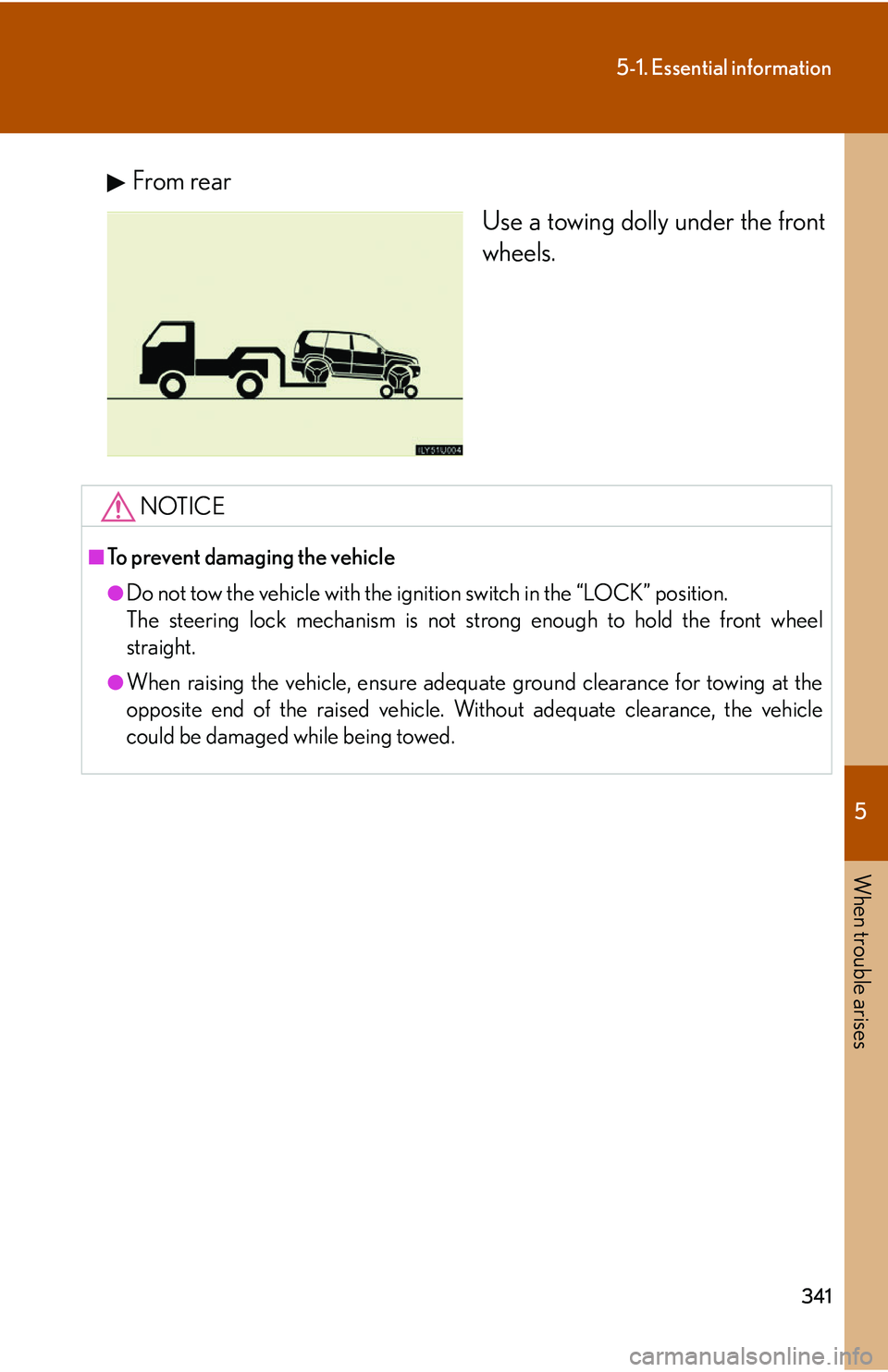
5
When trouble arises
341
5-1. Essential information
From rearUse a towing dolly under the front
wheels.
NOTICE
■To prevent damaging the vehicle
●Do not tow the vehicle with the igniti on switch in the “LOCK” position.
The steering lock mechanism is not st rong enough to hold the front wheel
straight.
●When raising the vehicle, ensure adequate ground clearance for towing at the
opposite end of the raised vehicle. Wi thout adequate clearance, the vehicle
could be damaged while being towed.
Page 365 of 436
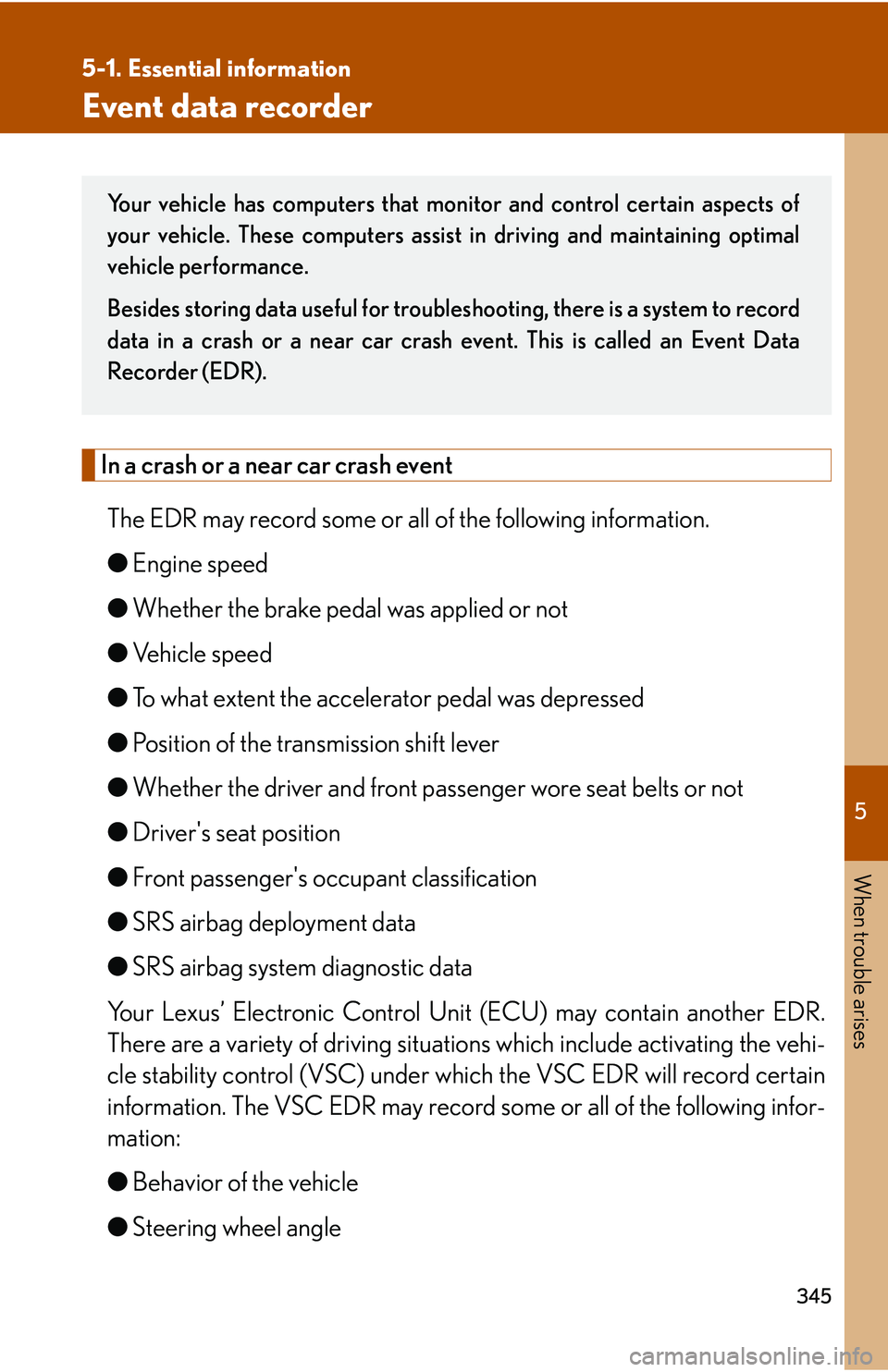
5
When trouble arises
345
5-1. Essential information
Event data recorder
In a crash or a near car crash eventThe EDR may record some or all of the following information.
● Engine speed
● Whether the brake pedal was applied or not
● Vehicle speed
● To what extent the accelerator pedal was depressed
● Position of the transmission shift lever
● Whether the driver and front passenger wore seat belts or not
● Driver's seat position
● Front passenger's occu pant classification
● SRS airbag deployment data
● SRS airbag system diagnostic data
Your Lexus’ Electronic Control U nit (ECU) may contain another EDR.
There are a variety of driving situation s which include activating the vehi-
cle stability control (VSC) under whic h the VSC EDR will record certain
information. The VSC EDR may record so me or all of the following infor-
mation:
● Behavior of the vehicle
● Steering wheel angle
Your vehicle has computers that monitor and control certain aspects of
your vehicle. These computers assist in driving and maintaining optimal
vehicle performance.
Besides storing data useful for troubles hooting, there is a system to record
data in a crash or a near car crash event. This is called an Event Data
Recorder (EDR).
Page 366 of 436
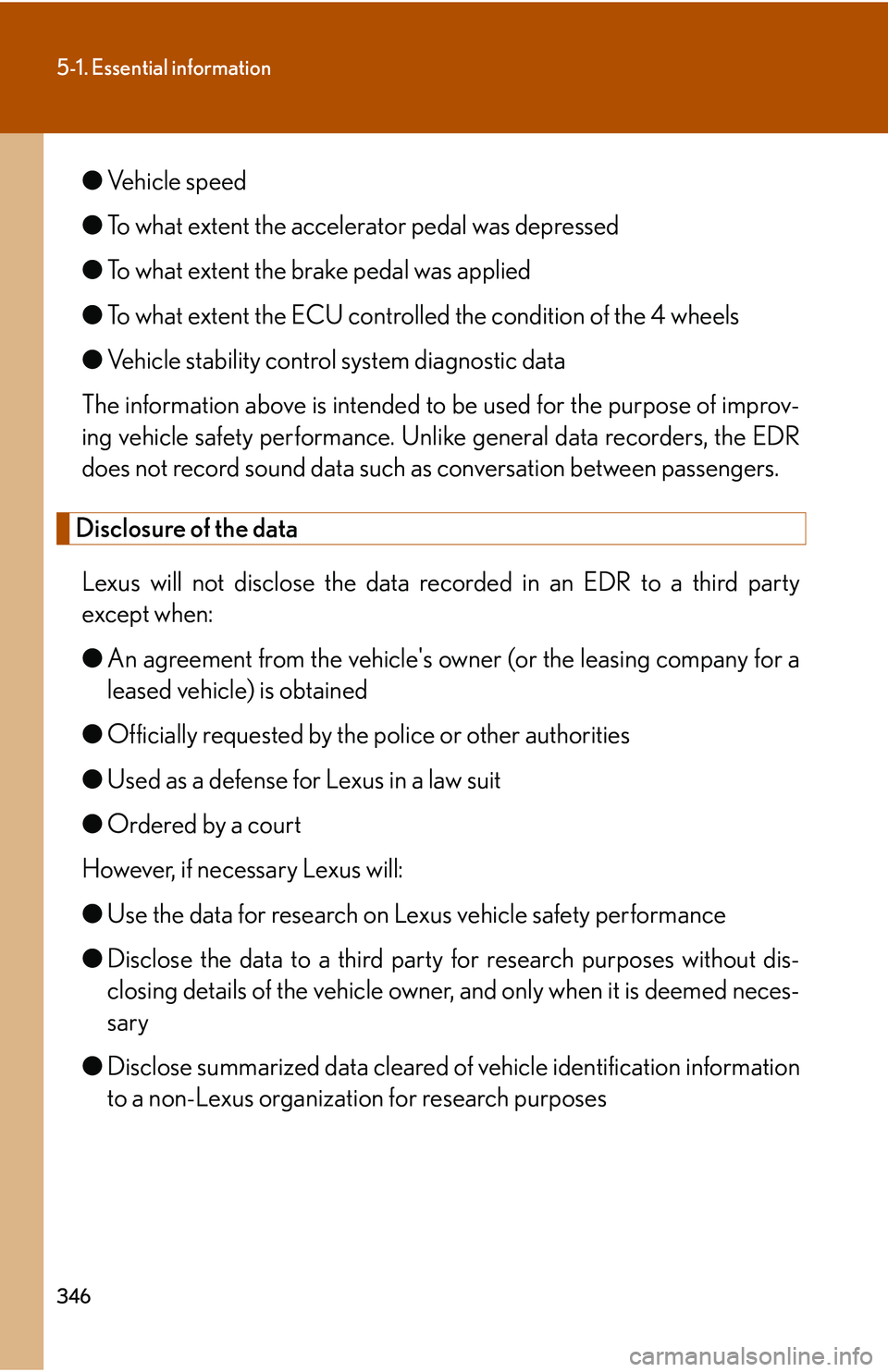
346
5-1. Essential information
●Vehicle speed
● To what extent the accelerator pedal was depressed
● To what extent the brake pedal was applied
● To what extent the ECU controlled the condition of the 4 wheels
● Vehicle stability control system diagnostic data
The information abov e is intended to be used for the purpose of improv-
ing vehicle safety performance. Unlike general da ta recorders, the EDR
does not record sound data such as conversation between passengers.
Disclosure of the data
Lexus will not disclose the data re corded in an EDR to a third party
except when:
● An agreement from the vehicle's ow ner (or the leasing company for a
leased vehicle) is obtained
● Officially requested by the police or other authorities
● Used as a defense for Lexus in a law suit
● Ordered by a court
However, if necessary Lexus will:
● Use the data for research on Le xus vehicle safety performance
● Disclose the data to a third party for research purposes without dis-
closing details of the vehicle owner, and only when it is deemed neces-
sary
● Disclose summarized data cleared of vehicle identification information
to a non-Lexus organization for research purposes
Page 373 of 436
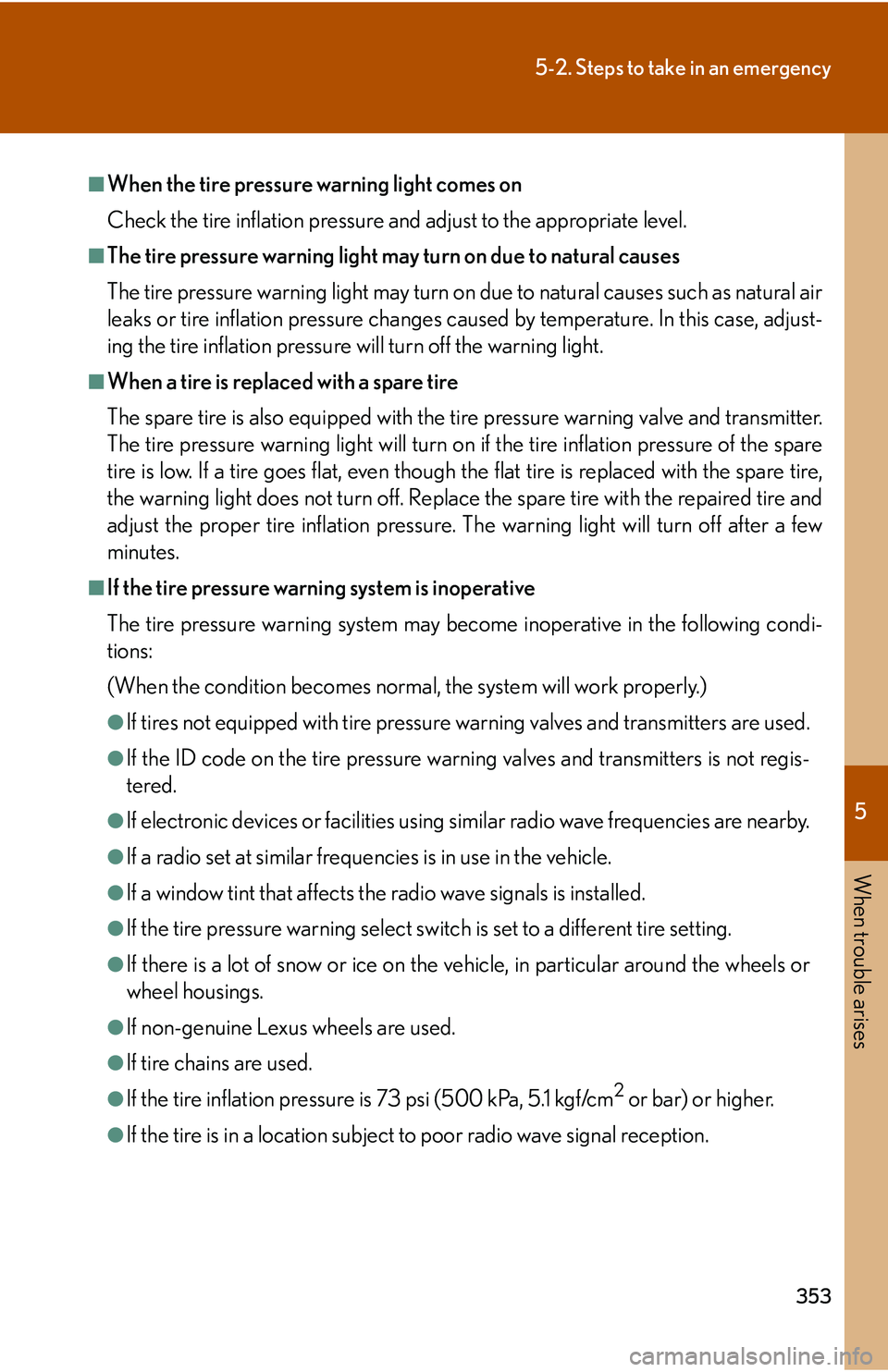
5
When trouble arises
353
5-2. Steps to take in an emergency
■When the tire pressure warning light comes on
Check the tire inflation pressure and adjust to the appropriate level.
■The tire pressure warning light may turn on due to natural causes
The tire pressure warning light may turn on due to natural causes such as natural air
leaks or tire inflation pressure changes caused by temperature. In this case, adjust-
ing the tire inflation pressure will turn off the warning light.
■When a tire is replaced with a spare tire
The spare tire is also equipped with the tire pressure warning valve and transmitter.
The tire pressure warning light will turn on if the tire inflation pressure of the spare
tire is low. If a tire goes flat, even though the flat tire is replaced with the spare tire,
the warning light does not turn off. Replace the spare tire with the repaired tire and
adjust the proper tire inflation pressure. The warning light will turn off after a few
minutes.
■If the tire pressure warning system is inoperative
The tire pressure warning system may become inoperative in the following condi-
tions:
(When the condition becomes normal, the system will work properly.)
●If tires not equipped with tire pressure warning valves and transmitters are used.
●If the ID code on the tire pressure warning valves and transmitters is not regis-
tered.
●If electronic devices or facilities using similar radio wave frequencies are nearby.
●If a radio set at similar frequencies is in use in the vehicle.
●If a window tint that affects the radio wave signals is installed.
●If the tire pressure warning select switch is set to a different tire setting.
●If there is a lot of snow or ice on the vehicle, in particular around the wheels or
wheel housings.
●If non-genuine Lexus wheels are used.
●If tire chains are used.
●If the tire inflation pressure is 73 psi (500 kPa, 5.1 kgf/cm2 or bar) or higher.
●If the tire is in a location subject to poor radio wave signal reception.
Page 375 of 436
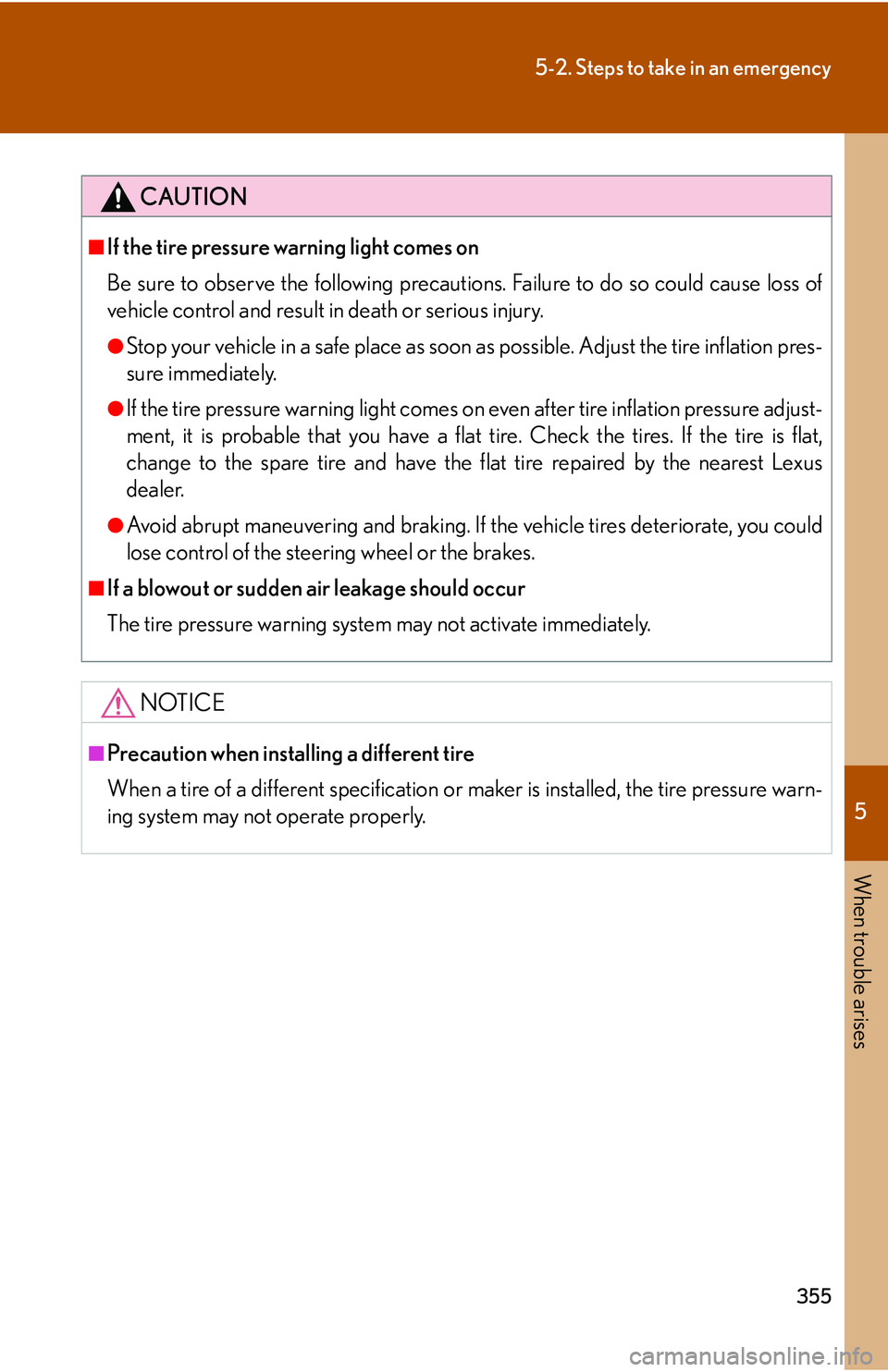
5
When trouble arises
355
5-2. Steps to take in an emergency
CAUTION
■If the tire pressure warning light comes on
Be sure to observe the following precautions. Failure to do so could cause loss of
vehicle control and result in death or serious injury.
●Stop your vehicle in a safe place as soon as possible. Adjust the tire inflation pres-
sure immediately.
●If the tire pressure warning light comes on even after tire inflation pressure adjust-
ment, it is probable that you have a flat tire. Check the tires. If the tire is flat,
change to the spare tire and have the flat tire repaired by the nearest Lexus
dealer.
●Avoid abrupt maneuvering and braking. If the vehicle tires deteriorate, you could
lose control of the steering wheel or the brakes.
■If a blowout or sudden air leakage should occur
The tire pressure warning system may not activate immediately.
NOTICE
■Precaution when installing a different tire
When a tire of a different specification or maker is installed, the tire pressure warn-
ing system may not operate properly.
Page 376 of 436
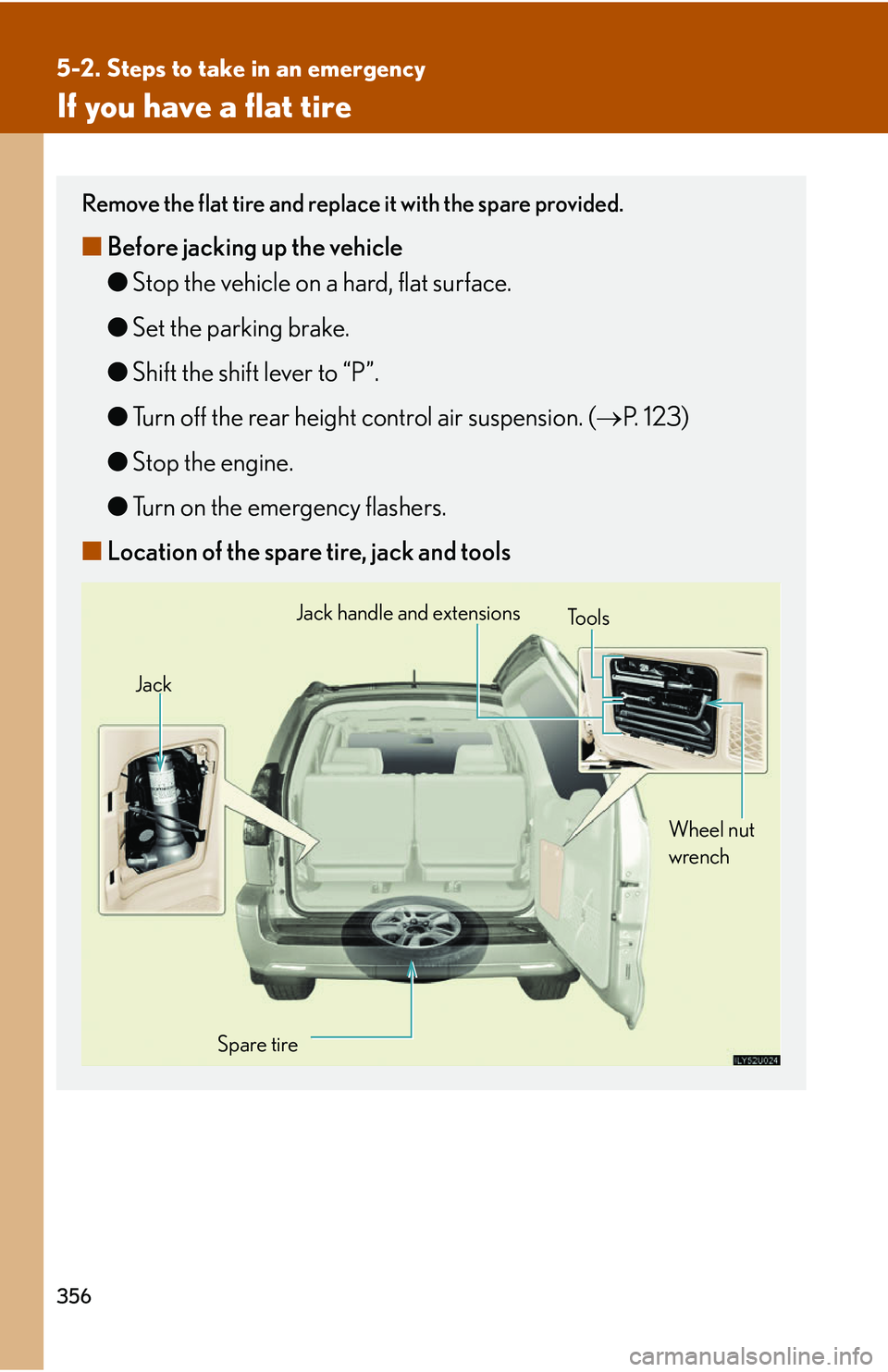
356
5-2. Steps to take in an emergency
If you have a flat tire
Remove the flat tire and replace it with the spare provided.
■Before jacking up the vehicle
●Stop the vehicle on a hard, flat surface.
● Set the parking brake.
● Shift the shift lever to “P”.
● Turn off the rear height control air suspension. ( P. 123)
● Stop the engine.
● Turn on the emergency flashers.
■ Location of the spare tire, jack and tools
Wheel nut
wrench
Spare tire
Jack
Tools
Jack handle and extensions
Page 379 of 436
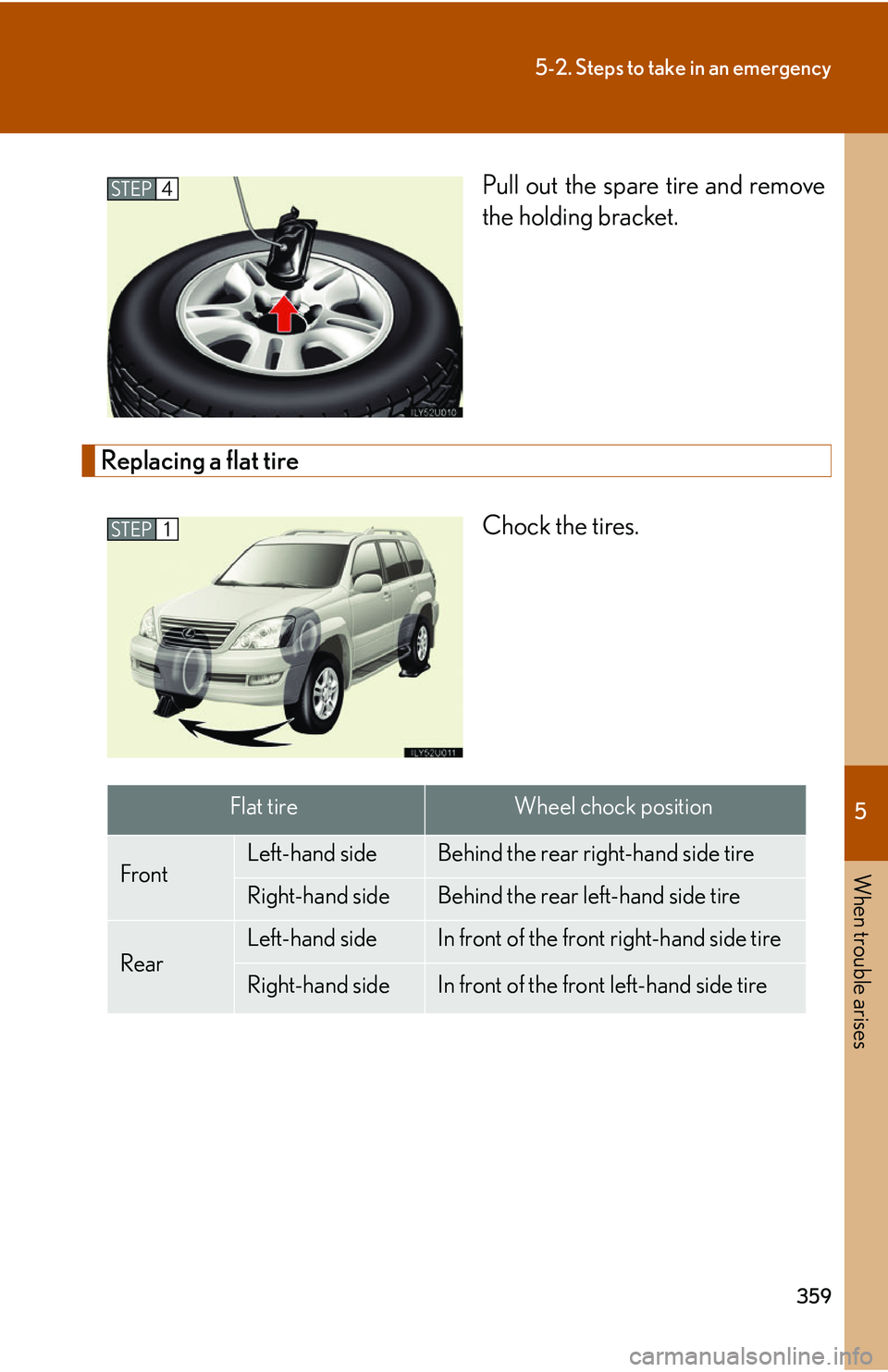
5
When trouble arises
359
5-2. Steps to take in an emergency
Pull out the spare tire and remove
the holding bracket.
Replacing a flat tireChock the tires.
STEP4
STEP1
Flat tireWheel chock position
FrontLeft-hand sideBehind the rear right-hand side tire
Right-hand sideBehind the rear left-hand side tire
Rear
Left-hand sideIn front of the front right-hand side tire
Right-hand sideIn front of the front left-hand side tire
Page 380 of 436
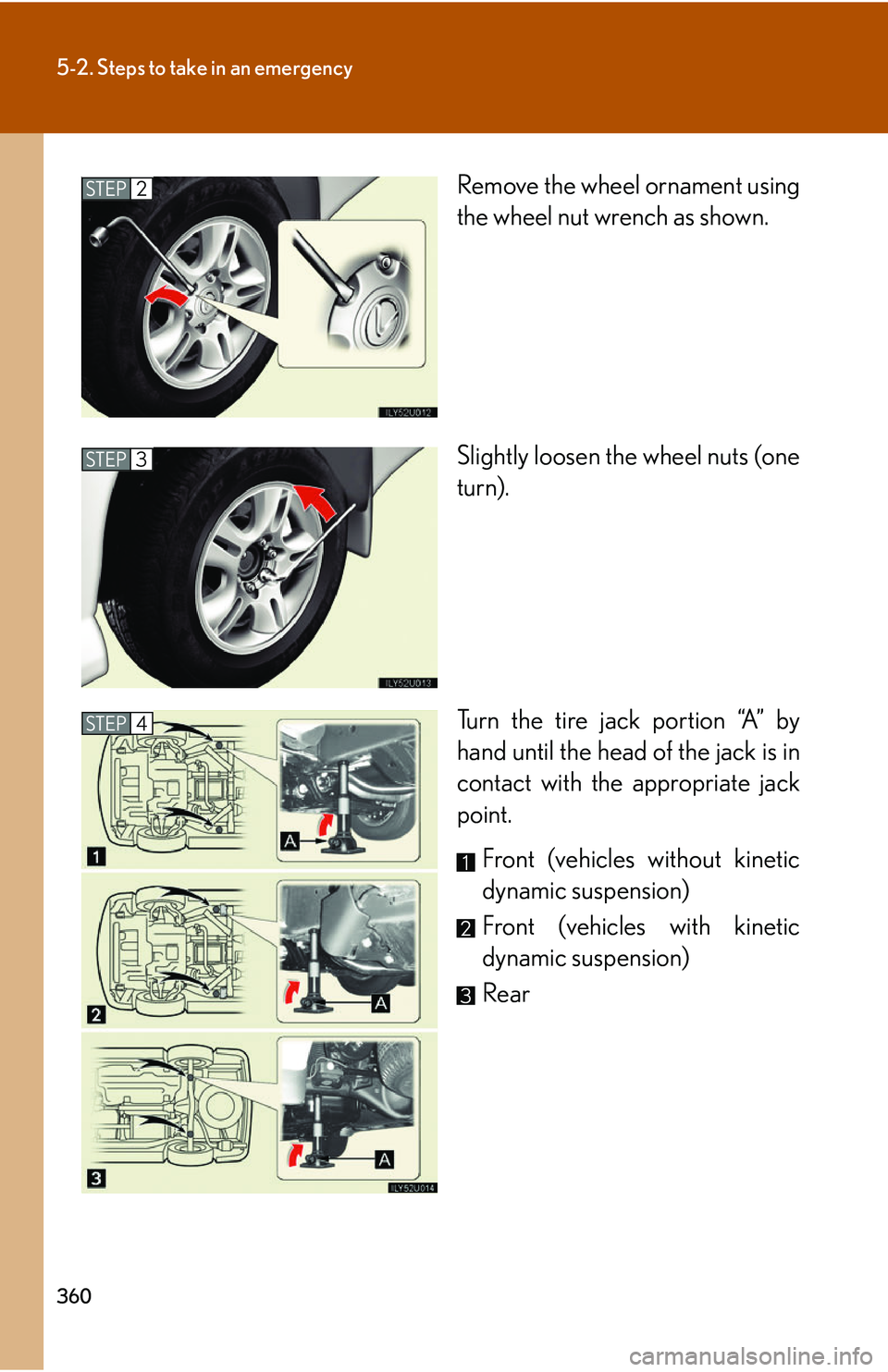
360
5-2. Steps to take in an emergency
Remove the wheel ornament using
the wheel nut wrench as shown.
Slightly loosen the wheel nuts (one
turn).
Turn the tire jack portion “A” by
hand until the head of the jack is in
contact with the appropriate jack
point.
Front (vehicles without kinetic
dynamic suspension)
Front (vehicles with kinetic
dynamic suspension)
RearSTEP2
STEP3
STEP4